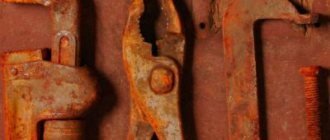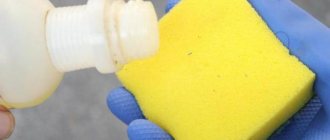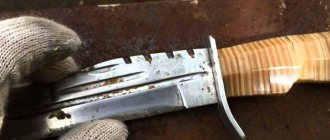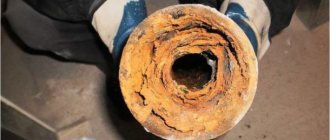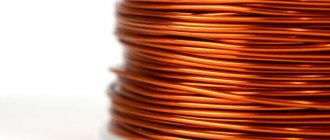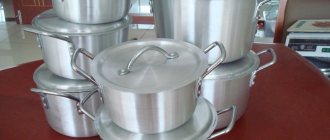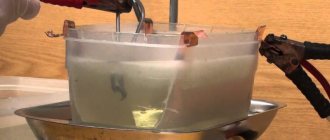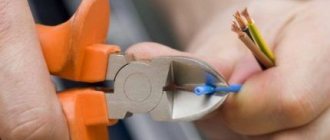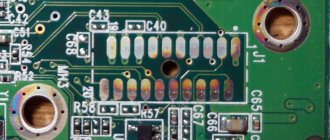Centuries ago, the first Turk was made from a very valuable metal of that time - copper.
But these dishes become dirty both inside and out. As you use the coffee pot, it appears from the fire - carbon deposits, from acidification - deposits and layers, as well as smudges.
High-quality and proper cleaning of Turks does not require the purchase of special detergents and does not require mastering special skills.
Natural remedies that are at hand are better at cleaning copper cezve.
How do Turks clean copper?
Dark oxide spots on the surface of the vessel are carbonate salts. Therefore, a copper vessel can be cleaned with acids that create compounds with oxides.
Lemon acid
The easiest way to clean a copper pot is to use citric acid or citrus itself. They can easily be found in every home. In addition, this is the most effective and harmless method.
They are used to clean the outside of the Turk.
The acid of the golden fruit removes tarnish on copper products well. Turku can be cleaned either with citrus juice or powdered acid.
After prolonged exposure, the acid will clean the appearance of copper, but at the same time it will form other stains. In this regard, the cezve should not be forgotten for a long time in citrus juice or in an acid solution. Traces of the substance must be eliminated more thoroughly.
It is recommended to use citric acid or regular lemon occasionally, alternating with other substances.
How to clean a cezve with regular lemon
They are peeled in two ways: with the golden fruit itself or with citrus and salt.
Take a non-wet Turk. Do not dip before cleaning.
Cut the lemon in half.
Rub the cezve with citrus fruit and set aside for a few minutes;
Using a soft brush, gently rub lemon juice onto the outside of the vessel;
Rinse off with plenty of heated clean water;
Wipe the outside with a cloth, preferably linen.
Or sprinkle each lemon slice with fine salt.
Rub this slice on the outside and leave for a while.
Then wipe the vessel with a rag, rinse and dry the Turk.
Polish with a cloth (for example, wool).
Citrus fruit acid
Cleaning Turks with citric acid powder is similar to the previous case. Dissolve the acid in a ratio equal to two teaspoons of powder per 200 ml of water. Apply this liquid to the outside of the Turk and cover with salt on top. Leave for 5-10 minutes, wipe with a soft cloth, wash, wipe dry again and polish.
The third option for cleaning Turka with citrus
Squeeze lemon juice and add salt until it reaches the consistency of porridge. Using a soft sponge, clean the surface of the Turka with the resulting mixture. Rinse and dry with a cloth.
Vinegar and salt
Turku can also be cleaned with acetic acid. However, to prevent excessive oxidation, the cezve should not be treated with acid in its pure form, but mixed with salt.
Vinegar with salt removes the most stubborn stains, and is also used for vessels with engraving or chasing.
Option 1: Cleaning with vinegar and salt scrub
You can rid the coffee pot of dark deposits using a vinegar-salt scrub:
Mix 2 tablespoons of vinegar with a tablespoon of finely ground salt. Apply the scrub with a napkin to the outside of the Turk. Rub everywhere.
And treat the engraving or embossing of the vessel with a toothbrush. Then rinse with water. Wipe the product dry and polish.
Option 2: Boiling in vinegar-salt solution
A dark stain on a copper Turk is removed by boiling the vessel in a solution of vinegar and salt:
Pour one glass of vinegar into a saucepan where the whole Turk is placed, pour one tablespoon of salt on top. Pour water over the mixture. Place the Turk in the solution. Place the container on the fire and boil everything until the oxides dissolve (about half an hour). Remove the vessel from the liquid and cool. Wash the cezve in soapy water, rinse well in clean water and finally wipe dry.
Option 3: a mixture of vinegar, wood sawdust and talcum powder
A copper pot can be cleaned with a mixture of vinegar, wood sawdust and talc:
Mix sawdust and talc in a ratio of 2 to 1 and dilute with vinegar to a paste-like consistency. Rub the mixture onto the turk with a sponge. Allow to dry completely and polish with a cloth. To protect and prevent irritation of the skin of your hands, wear gloves.
Option 4: cleaning with vinegar test
To prevent excessive oxidation of the metal, you can use the recipe for a test with vinegar:
Mix 1 tablespoon of salt with a glass of vinegar. Vinegar should be in a concentration ranging from 6 to 8%. Add flour gradually until the consistency of porridge is created (about 2 tbsp).
Lubricate the finished paste onto the unclean parts of the Turks or entirely. Then let dry (about 40 minutes). Thoroughly clean the paste with a dry old toothbrush. Rinse and wipe dry.
Dough with vinegar is used in cleaning cezves with engraving or chasing. It perfectly removes deposits in recessed areas where access is limited.
Ketchup
Tomatoes contain a lot of ascorbic and citric acids. They react with the metal and help remove dirt. Therefore, copper Turks can be perfectly cleaned with their help.
Cut the tomato in half. The Turks wipe the outside with this tomato and clean it with a brush.
Ketchup also effectively fights plaque. The Turk is easy to clean with ketchup: you need to smear the walls with the sauce, wait a little, then clean it in the usual way.
You can also cover the Turk with ketchup in a pan and wash it after 15-20 minutes. Then wipe dry with a cloth and polish.
Tomato sauce removes brown deposits from metal.
Ketchup that has expired will also come in handy. Ketchup returns the natural shine to a copper product.
Milk serum
A waste product from the dairy industry, whey has been used since ancient times in households to cleanse vessels.
The cezve is placed in a bowl with heated whey. It should be warm. The vessel should be covered with liquid within half an hour. Then rub with a sponge, cloth or brush, rinse and wipe.
Rub dried deposits with salt and treat with whey.
There is also a more effective way: dissolve salt in whey to a saturated solution (a tablespoon per cup), soak a cloth in the mixture (flannel is recommended) and rub a copper pot with it. You need to make sure that there are no grains of salt left on the fabric, which could damage the surface of the vessel.
Cover areas that cannot be wiped off with a cloth well moistened with serum and leave. Then clean thoroughly. Wash the processed cezve in water. Dry and polish.
Ammonia
The coffee cezve can be cleaned with ammonia.
Ammonia, aka ammonium, aka volatile alkali, ammonia among the people, is an overly active chemical compound.
In this regard, work with it must be carried out correctly. The product removes deep impurities and fights green-brown spots.
Ammonia, by binding oxidizing products, forms a complex. It can be easily washed with warm soapy water.
If not thoroughly washed, ammonia residues can form new compounds on the surface of the vessel. Therefore, after cleaning, the Turk must be washed well with plenty of water.
Option 1:
Dilute ammonia with water in a ratio of 1 to 2. Moisten a rag with the solution. Use it to wipe the outside of the Turks. Then wash in soapy water. Dry the cezve with a soft cloth.
Option 2:
To clean a copper pot, it needs to be placed in an ammonium solution for a short time. For the solution, take an equal amount of ammonia and water and soak the cezve in this solution for 10-20 minutes. Then rinse with clean water and wipe the vessel.
Tips for working with ammonia: Always wash off the turk with heated soapy water. When working with ammonia, ventilate the room. Wear gloves and avoid contact with the mucous membrane of the eyes. Otherwise, ammonia has a pungent odor and is a dangerous compound.
Option 3:
A copper pot can also be cleaned with a mixture of ammonium, crushed chalk and water: mix the substances in a ratio of 3:1:6. Shake the mixture. Apply the solution to the outside of the casing with a sponge. Thoroughly clean off deposits on the surface of the vessel. Rinse off the remaining mixture with water. Wipe and polish the vessel.
Before you begin cleaning using the above methods, you must first test the reaction of copper and the product on a small area of the product. Start using the cleaning agent on the entire surface of the Turk, if no negative reaction is detected.
Ammonia can be found in every pharmacy.
Brine
Any brine is well suited for the purpose of washing Turks: sauerkraut, cucumber, tomato, etc. They are well used for cleaning metal vessels.
The Turk needs to be immersed in liquid for a while. Or you can cover it with a flannel cloth moistened in brine. The saline solution will remove dirt. Then you need to wash off the brine with soap and water, and finally wipe dry.
How to clean a copper Turk using a dry method
The cezve is also cleaned with abrasives. Since a copper casing can cause an unpredictable reaction when cleaning the outside with acidic agents, you can use a less safe method. Cleaning from dirt mechanically using dry abrasives in powder form.
But they should not contain large fractions. Crushed chalk, flour, soda, tooth powder, talc, sawdust, and GOI paste are used as cleaning agents.
Coarse salt is not suitable for cleaning the Turk. Salt crystals that are too large can leave scratches on the copper surface.
The method of using these substances is simple:
Apply the crushed powder of the substance to a soft cloth (cloth or flannel).
Rub the outside of the Turk with the product.
Rinse and dry.
Flour, tooth powder and other substances are used in the same way.
Cleaning a copper Turk from the inside
It is difficult to clean the Turk from the inside due to the narrow neck and inaccessibility of the bottom. However, the problem can be solved.
To clean the inside, pour water into a copper pot and pour two tsp. soda and let it boil. After a couple of minutes, the plaque easily dissolves. If it does not come off, you need to rub it with a brush.
Turks with thick deposits can also be cleaned by completely immersing them in a soda solution.
For cleaning you need: a large saucepan; soda (1 tbsp per 1 liter of water); crushed household soap (2 tsp per 1 liter of water).
To remove heavy deposits, add citric acid or vinegar. Mix the contents and heat, immerse in the Turk. After boiling, reduce the flame and simmer for about half an hour. After this, remove the Turk from the liquid and clean it with a brush or brush until the plaque is completely removed.
Terms of use
Every coffee connoisseur will confirm that if the drink boils, it loses all its value - its exquisite aroma and taste. For this reason, coffee should be brewed rather than boiled. It happens like this:
- you should pour ground coffee into the container;
- add sugar to taste;
- fill with cold water;
- place the Turk on a stove or sand and wait for the liquid to heat up;
- mix thoroughly until foam forms;
- When the first bubbles appear and the foam darkens, the Turk should be removed from the stove or sand.
You cannot place a copper pot on a glass-ceramic stove. Be sure to use an adapter that will prevent direct contact between the copper and the surface of the plate.
How to properly care for a copper pot
Copper Turk requires very simple care rules. With proper care, the vessel will last a long time.
Copper products do not tolerate sudden changes in temperature conditions. Therefore, after removing the vessel from the flame, you cannot immediately cool it in water. This may ruin the coffee pot.
To avoid damage to the walls, the Turka is stored separately from other products.
It is stored in a paper bag or wrapped in cloth or newspaper.
The cezve should be washed off immediately after brewing coffee. This prevents plaque from forming. It is best to rinse immediately after use to prevent any remaining coffee grounds from drying out and hardening.
If the bottom is poorly cleaned, then rub it with grated powdery substances such as salt, soda or chalk.
Turku is polished from the inside with non-abrasive toothpaste, and the surface is polished with non-colored, rolled-up newspaper. Then wash in water.
For cleaning, the Turks do not use aggressive household chemicals or harsh abrasive products. It is also strictly not recommended to use acids such as oxalic or hydrochloric acid.
You cannot clean a copper pot with coarse salt and sand. They can damage the walls.
The copper pot should be stored in a dry, ventilated area.
After washing, the copper casing is wiped until dry.
The Turk occasionally needs to be polished with a small piece of dense and delicate cloth.
By following these simple rules, you can enjoy freshly brewed coffee from your favorite copper cezve for a long time.
Useful tips
To ensure that copper items last longer, they should not be cleaned with abrasives or rubbed with metal brushes. Copper is a fairly soft metal and is easily scratched by hard objects.
It is better to store copper utensils, jewelry, embossing and coins in a special cabinet. It must be dry and ventilated. In such conditions, things made of copper retain their attractive appearance. If objects are kept in constant humidity under conditions of a significant increase in temperature, they quickly lose their attractiveness and become covered with patina.
You cannot cook food containing foods with a high acid content in copper cookware. This renders kitchen utensils unusable. When cookware has a decorative coating, it should not be polished or cleaned with abrasive materials. Such items can only be washed in heated water using a soap solution. Periodically wipe all copper utensils with a clean, soft cloth to prevent dust and soot from settling on them.
